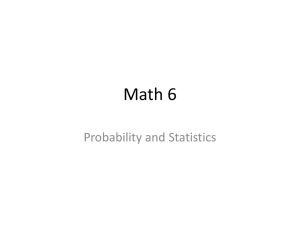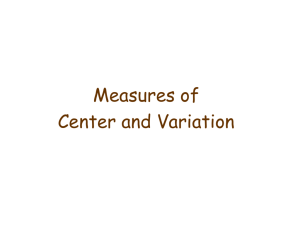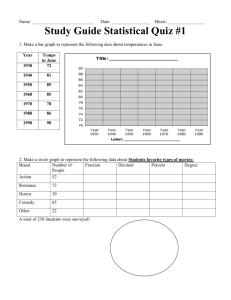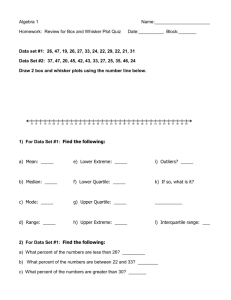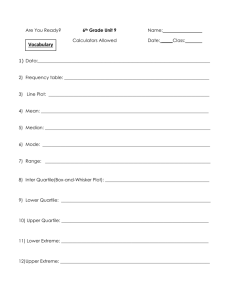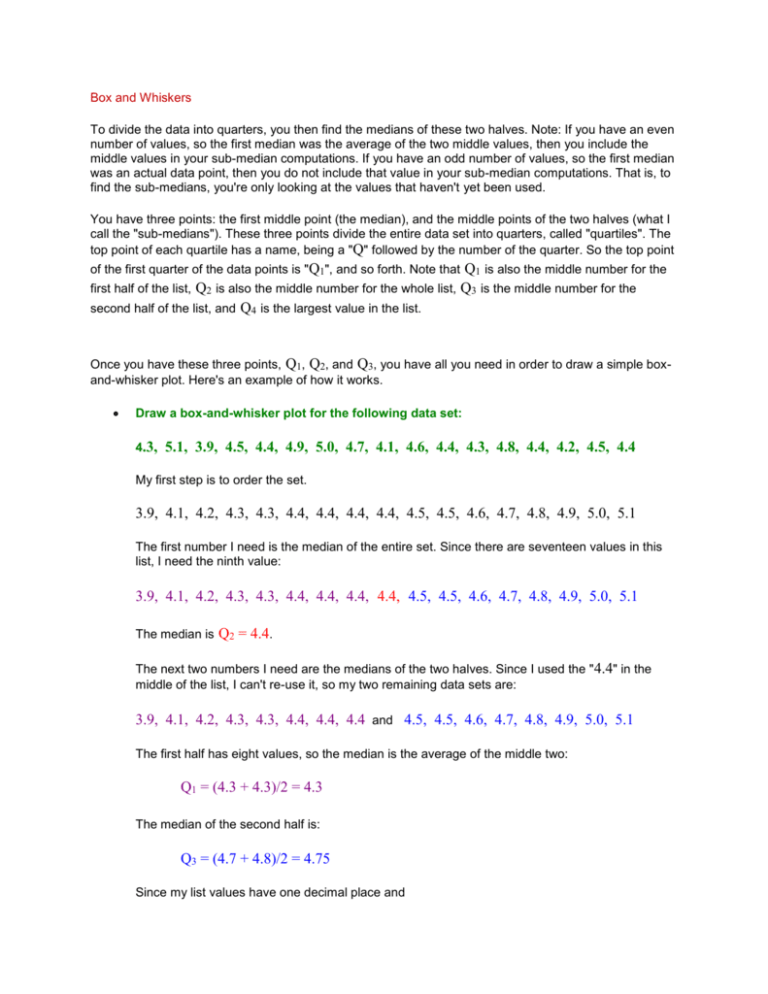
Box and Whiskers
To divide the data into quarters, you then find the medians of these two halves. Note: If you have an even
number of values, so the first median was the average of the two middle values, then you include the
middle values in your sub-median computations. If you have an odd number of values, so the first median
was an actual data point, then you do not include that value in your sub-median computations. That is, to
find the sub-medians, you're only looking at the values that haven't yet been used.
You have three points: the first middle point (the median), and the middle points of the two halves (what I
call the "sub-medians"). These three points divide the entire data set into quarters, called "quartiles". The
top point of each quartile has a name, being a "Q" followed by the number of the quarter. So the top point
of the first quarter of the data points is "Q1", and so forth. Note that
Q1 is also the middle number for the
first half of the list, Q2 is also the middle number for the whole list, Q3 is the middle number for the
second half of the list, and Q4 is the largest value in the list.
Once you have these three points, Q1, Q2, and Q3, you have all you need in order to draw a simple boxand-whisker plot. Here's an example of how it works.
Draw a box-and-whisker plot for the following data set:
4.3,
5.1, 3.9, 4.5, 4.4, 4.9, 5.0, 4.7, 4.1, 4.6, 4.4, 4.3, 4.8, 4.4, 4.2, 4.5, 4.4
My first step is to order the set.
3.9, 4.1, 4.2, 4.3, 4.3, 4.4, 4.4, 4.4, 4.4, 4.5, 4.5, 4.6, 4.7, 4.8, 4.9, 5.0, 5.1
The first number I need is the median of the entire set. Since there are seventeen values in this
list, I need the ninth value:
3.9, 4.1, 4.2, 4.3, 4.3, 4.4, 4.4, 4.4, 4.4, 4.5, 4.5, 4.6, 4.7, 4.8, 4.9, 5.0, 5.1
The median is
Q2 = 4.4.
The next two numbers I need are the medians of the two halves. Since I used the " 4.4" in the
middle of the list, I can't re-use it, so my two remaining data sets are:
3.9, 4.1, 4.2, 4.3, 4.3, 4.4, 4.4, 4.4 and 4.5, 4.5, 4.6, 4.7, 4.8, 4.9, 5.0, 5.1
The first half has eight values, so the median is the average of the middle two:
Q1 = (4.3 + 4.3)/2 = 4.3
The median of the second half is:
Copyright © Elizabeth Stapel 2004-2011 All Rights Reserved
Q3 = (4.7 + 4.8)/2 = 4.75
Since my list values have one decimal place and
range from 3.9 to 5.1, I won't use a scale of, say,
zero to ten, marked off by ones. Instead, I'll draw a
number line from 3.5 to 5.5, and mark off by tenths.
Now I'll mark off the minimum and maximum values,
and Q1, Q2, and Q3:
The "box" part of the plot goes from
Q1 to Q3:
And then the "whiskers" are drawn to the endpoints:
By the way, box-and-whisker plots don't have to be drawn horizontally.
BOX PLOT
What it is:
The box plot is a graphical representation of data that shows a data set’s lowest value, highest
value, median value, and the size of the first and third quartile. The box plot is useful in
analyzing small data sets that do not lend themselves easily to histograms. Because of the small
size of a box plot, it is easy to display and compare several box plots in a small space. A box plot
is a good alternative or complement to a histogram and is usually better for showing several
simultaneous comparisons.
How to use it:
Collect and arrange data. Collect the data and arrange it into an ordered set from lowest value
to highest.
Calculate the depth of the median. d(M) = (n1)/ 2
where d = depth; the number of observations to count from the beginning of the ordered
data set
M = median, n = number of observations in the set of data
If the ordered data set contains an odd number of values, the formula will identify which of the
values will be the median. If the ordered data set contains an even number of values, the median
will be midway between two of the values.
Calculate the depth of the first quartile. d(Q1) = ((1)n 2)/4
where d = depth; the number of observations to count from the beginning of the ordered
data set
(Q1) = the first quartile, n = number of observations in the set of data
The first quartile will be the value of the data item identified by this formula.
Calculate the depth of the third quartile. d(Q3) = ((3)n 2)/4
where d = depth; the number of observations to count from the beginning of the ordered
data set
(Q3) = the third quartile, n = number of observations in the set of data
The third quartile will be the value of the data item identified by this formula.
Calculate the interquartile rage (IQR). This range is the difference between the first and
third quartile vales. (Q3 - Q1)
Calculate the upper adjacent limit. This is the largest data value that is less than or equal to
the third quartile plus 1.5 X IQR. Q3 + [(Q3 - Q1) X 1.5]
Calculate the lower adjacent limit. This value will be the smallest data value that is greater
than or equal to the first quartile minus 1.5 X IQR. Q1 - [(Q3 - Q1) X 1.5]
Draw and label the axes of the graph. The scale of the vertical axis must be large enough to
encompass the greatest value of the data sets. The horizontal axis must be large enough to
encompass the number of box plots to be drawn.
Draw the box plots. Construct the boxes, insert median points, and attach upper and lower
adjacent limits.. Identify outliers (values outside the upper and lower adjacent limits) with
asterisks.
Analyze the results. A box plot shows the distribution of data. The line between the lowest
adjacent limit and the bottom of the box represent one-fourth of the data. One-fourth of the data
falls between the bottom of the box and the median, and another one-fourth between the median
and the top of the box. The line between the top of the box and the upper adjacent limit
represents the final one-fourth of the data observations.
Box Plot Example





